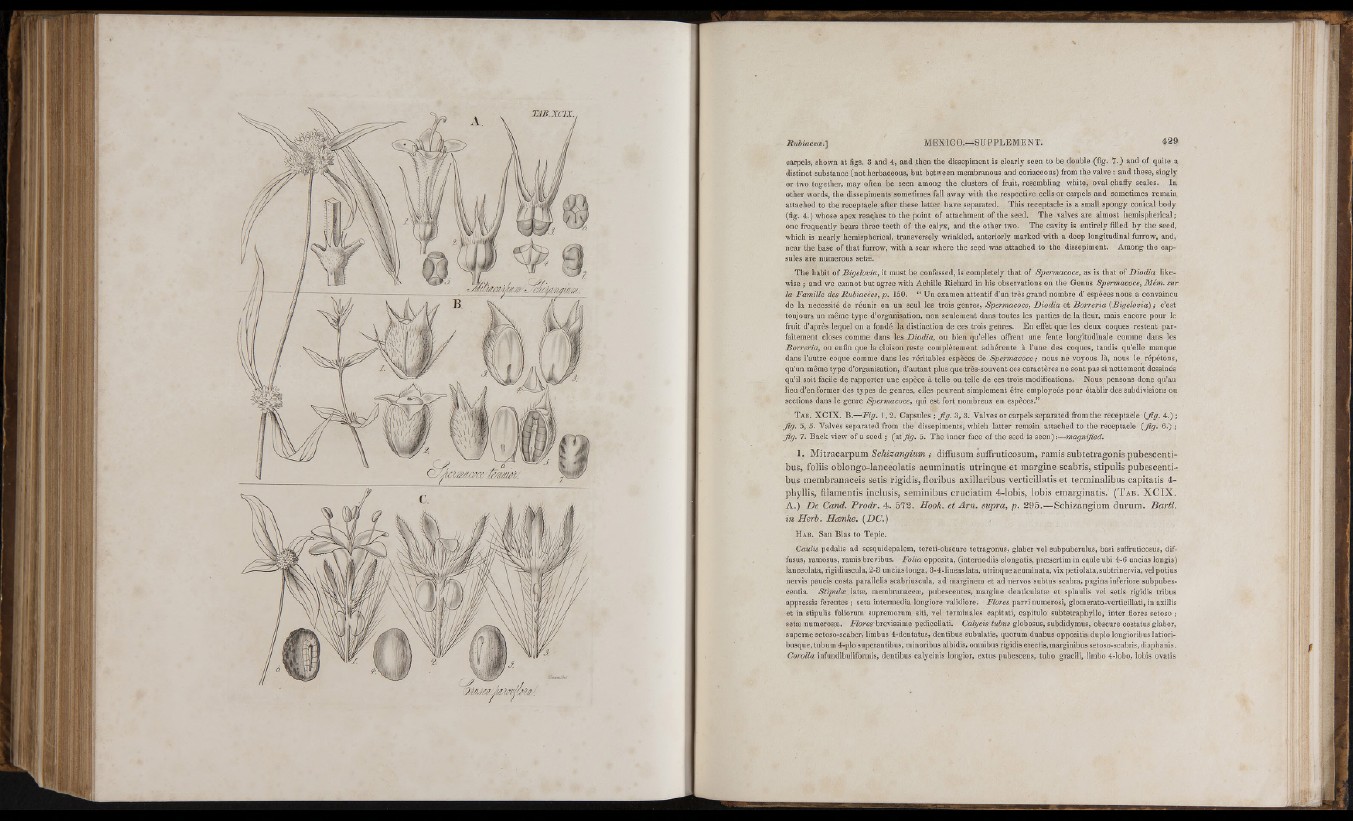
Rubiacea.] M EX IC O .-SU P P L EM E N T . 429
carpels, shown at figs. 3 and 4, and then the dissepiment is clearly seen to be double (fig. 7 .) and of quite a
distinct substance (not herbaceous, but between membranous and coriaceous) from the valve : and these, singly
or two together, may often be seen among the clusters of fruit, resembling white, oval chaffy scales. In
other words, the dissepiments sometimes fall away with the respective cells or carpels and sometimes remain
attached to the receptacle after these latter have separated. This receptacle is a small spongy conical body
(fig. 4.) whose apex reaçhes to the point of attachment of the seed. The valves are almost hemispherical;
one frequently bears three teeth of the calyx, and the other two. The cavity is entirely filled by the seed,
which is nearly hemispherical, transversely wrinkled, anteriorly marked with a deep longitudinal furrow, and,
near the base of that furrow, with a scar where the seed was attached lo the dissepiment. Among the capsules
are numerous setæ.
The habit of Bigelovia, it must be confessed, is completely that of Spermacoce, as is that of Diodia likewise
; and we cannot but agree with Achille Richard in his observations on the Genus Spermacoce, Mém. sur
la Famille des Rubiacées, p . 150. “ Un examen attentif d’un très grand nombre d’ espèces nous a convaincu
de la nécessité de réunir en un seul les trois genres, Spermacoce, Diodia et Borreria {Bigelovia) ; c’est
toujours un même type d’organisation, non seulement dans toutes les parties de la fleur, mais encore pour le
fruit d’après lequel on a fondé la distinction de ces trois genres. En effet que les deux coques restent parfaitement
closes comme dans les Diodia, ou bien qu’elles offrent une fente longitudinale comme dans les
Borreria, ou enfin que la cloison reste complètement adhérente à l’une des coques, tandis qu’elle manque
dans l’autre coque comme dans les véritables espèces de Spermacoce; nous ne voyous là, nous le répétons,
qu’un même type d’organisation, d’autant plus que très-souvent ces caractères ne sont pas si nettement dessinés
qu’il soit facile de rapporter une espèce à telle ou telle de ces trois modifications. Nous pensons donc qu’au
lieu d’en former des types de genres, elles peuvent simplement être employees pour établir des subdivisions ou
sections dans le genre Spermacoce, qui est fort nombreux en espèces.”
T ab. XCIX. B.—Fig. 1 , 2 . Capsules ; flg . 3, 8. Valves or carpels separated from the receptacle {Jig. 4.) ;
Jig. 5, 5. Valves separated from the dissepiments, which latter remain attached to the receptacle {Jig. 6.) ;
Jig. 1. Back view of a seed ; (at Jig. 5. The inner face of the seed is seen):—magnified.
1. M itrac a rp um Schizangium ; diffusum suffruticosum, ramis subtetragonis pubescentibus,
foliis oblongo-lanceolatis acuminatis utrinque et margine scabris, stipulis pubescentibus
membranaceis setis rigidis, floribus axillaribus verticillatis e t terminalibus capitatis 4-
phyllis, filamentis inclusis, seminibus cruciatim 4-lobis, lobis emarginatis. (T a b . X C IX .
A.) De Cand, Prodr. 4. 572. Hook, et Arn. supra, p. 2 9 5 .—Schizangium d u rum . B a rtl.
in Herb. Hcenke, {DC.)
H a b . Sail Bias to Tepic.
Caulis pedalis ad sesquidepalera, tereti-obscure tetragonus, glaber vel subpuberulus, basi suffruticosus, diffusus,
ramosus, ramis brevibus. Folia opposita, (intemodiis eiongatis, præsertim in caule ubi 4-6 uncias longis)
lanceolata, rigidi uscula, 2-3 uncias longa, 3-4-lineaslata, utrinque acuminata, vix petiolata, subtrinervia, vel potius
nervis paucis costa parallelis scabriuscula, ad marginem et ad ñervos subtus scabra, pagina inferiore subpubes-
centia. Stipuloe latæ, membranaceæ, pubescentes, margine denticulatæ et spinulis vel setis rigidis tribus
appressis ferentes ; seta intermedia longiore validiore. Flores parvi numerosi, glomerato-verticillati, in axillis
et in stipulis foliorum supremorum siti, vel terminales capitati, capitulo subtetraphyllo, inter flores setoso ;
setæ numerosæ. irfores brevissime pedicellati. Calycis tubus globosus, subdidymus, obscure costatus glaber,
superne setoso-scaber, limbus 4-dontatus, dentibus subulatis, quorum duabus oppositis duplo longioribus latiori-
busque, tubum 4-plo superantibus, minoribus albidis, omnibus rigidis erectis, marginibus setoso-scabris, diaphanis.
Corolla infundibuliformis, dentibus calycinis longior, extus pubescens, tubo gracili, limbo 4-lobo, lobis ovatis